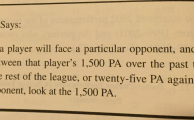Welcome to the second segment in my series documenting my own journey of getting started with daily fantasy baseball. In the first segment I did some introductory background reading, started to identify some analysts I can trust, took notes about research topics to focus on, and started planning features to be included in an Excel spreadsheet.
In this next segment we will take a closer look at some of the biggest myths that I’m seeing perpetuated out there.
I Can’t Believe We Even Have to Talk About This
I didn’t think I’d have to say anything like that until my daughters were teenagers… But here we are.
Just because you read something on the internet doesn’t make it true. We’ve all heard that before, right? I got up on my soapbox at the end of Part 1 and warned you to be careful out there… And here’s an example of why:
I would argue that BvPs are the most reliable out of all the sets we commonly use because they have the most amount of similar variables.
While it is wrong to accept BvPs as fact, it is equally wrong to discount their merit entirely.
BvPs are just one of the many things you should consider when building a roster but they are not the only thing.
Those are all from the same article talking about the merits of BvPs, or “Batter versus Pitcher” statistics. I promise you the article exists but I am not going to link to it. I’m not here to start fights. I merely want to point out that this misinformation exists, both in the form of online advice and it must also be a viable strategy in some DFS players’ minds.
Why Are You So Confident That BvPs Don’t Matter?
I can definitively say they don’t because it’s been studied by people much smarter than me. Studies using years and years of MLB data have been completed on this topic multiple times and have found that batter-vs-pitcher (or “BvPs”) information is not predictive unless you are talking at least a history of over 100 ABs between the two players.
So we have credible studies based on oodles of data performed by very smart people. Or we have baseless claims, anecdotes of individual examples, and Paul Goldschmidt’s numbers against Tim Lincecum on the other side.
If you find a study that suggest BvPs are meaningful, please let me know. But from what I have seen so far, it appears to be very irresponsible to suggest BvPs have value.
What Research Are You Referring To?
The main and most well known study I’m referring to is from “The Book” by Tom Tango, Mitchel Lichtman, and Andrew Dolphin. They studied “batters owning pitchers” and flipped it and studied “pitchers owning batters” from the time frame of 1999-2001. They identified players that “owned” other players during that three year span. Then they looked at what happened for those same players in 2002. In a very nice coincidence, in 2002 the hitters had 361 plate appearances against the pitchers they “owned”. And in that same season the pitchers had 361 plate appearances against hitters they “owned”.
The results were that the hitters had a wOBA of .349 against the pitchers they owned. These 30 hitters that were studied had wOBAs against those same pitchers ranging from .500 – .800 the two prior seasons. Then in 2002 they hit a combined .349, which is essentially league average.
And the pitchers that had dominated a group of batters allowed a wOBA of .343. Those 30 pitchers had wOBAs allowed ranging from below .100 to .210 from 1999 – 2001. Then in 2002 they too only allowed a league average wOBA against.
The results in The Book are clear: (more…)







